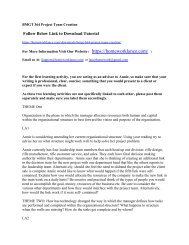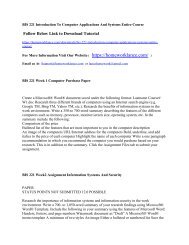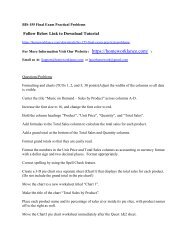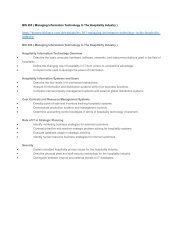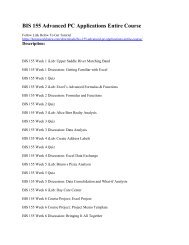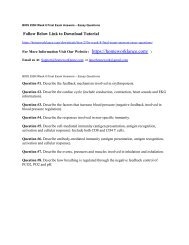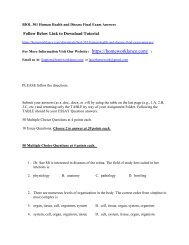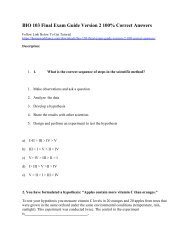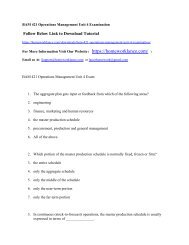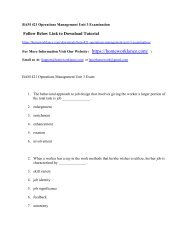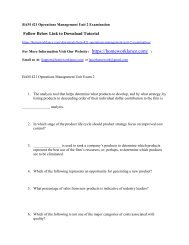BAM 421 Operations Management Unit 1 Examination
BAM 421 Operations Management Unit 1 Examination
BAM 421 Operations Management Unit 1 Examination
Create successful ePaper yourself
Turn your PDF publications into a flip-book with our unique Google optimized e-Paper software.
<strong>BAM</strong> <strong>421</strong> <strong>Operations</strong> <strong>Management</strong> <strong>Unit</strong> 1 <strong>Examination</strong><br />
Follow Below Link to Download Tutorial<br />
https://homeworklance.com/downloads/bam-<strong>421</strong>-operations-management-unit-1-examination/<br />
For More Information Visit Our Website ( https://homeworklance.com/ )<br />
Email us At: Support@homeworklance.com or lancehomework@gmail.com<br />
1. Reasons to study <strong>Operations</strong> <strong>Management</strong> include learning about _______________.<br />
<br />
<br />
<br />
<br />
<br />
a costly part of the enterprise<br />
what operations managers do<br />
how goods and services are produced<br />
how people organize themselves for productive enterprise<br />
All of the above<br />
2. An operations manager is not likely to be involved in ______________.<br />
<br />
<br />
<br />
<br />
<br />
the quality of goods and services to satisfy customers’ wants and needs<br />
the design of goods and services to satisfy customers’ wants and needs<br />
the identification of customers’ wants and needs<br />
maintenance schedules<br />
work scheduling to meet the due dates promised to customers<br />
3. Which of the following are part of the Ten Critical Decisions of <strong>Operations</strong><br />
<strong>Management</strong>?<br />
4. design of goods and services<br />
5. managing quality
III. layout strategy<br />
1. marketing<br />
2. pricing of goods and services<br />
I,II,IV<br />
I,II,V<br />
II,III,V<br />
I,II,III<br />
All of the abov<br />
4. Henry Ford is noted for his contributions to _______________.<br />
<br />
<br />
<br />
<br />
<br />
time and motion studies<br />
material requirements planning<br />
assembly line operations<br />
statistical quality control<br />
scientific management<br />
5. Which of the following is the best example of a pure service?<br />
<br />
<br />
<br />
<br />
<br />
electric co-op<br />
counseling<br />
oil change<br />
heart transplant<br />
All of the above
6. Which is not true regarding differences between goods and services?<br />
<br />
<br />
<br />
<br />
<br />
Goods tend to have higher customer interaction than services.<br />
Services tend to be more knowledge-based than goods.<br />
Services are generally produced and consumed simultaneously; tangible goods are not.<br />
Services tend to have a more inconsistent product definition than goods.<br />
None of the above are true<br />
7. Current trends in operations management include all of the following EXCEPT<br />
______________.<br />
<br />
<br />
<br />
<br />
<br />
empowered employees<br />
mass customization<br />
rapid product development<br />
just-in-time performance<br />
All of the above are current trends.<br />
8. The Dulac Box plant works two 8-hour shifts each day. In the past, 500 cypress<br />
packing boxes were produced by the end of each day. The use of new technology has<br />
enabled them to increase productivity by 30%. Productivity is now approximately<br />
______________.<br />
<br />
<br />
<br />
5 boxes/hr<br />
6 boxes/hr<br />
5 boxes/hr
25 boxes/hr<br />
300 boxes/hr<br />
9. Which of the following are among the ethical and social challenges facing operations<br />
managers?<br />
<br />
<br />
<br />
<br />
<br />
developing low-cost products<br />
providing an efficient workplace<br />
maintaining a sustainable environment<br />
honoring financial commitments<br />
All of the above<br />
10. Cost cutting in international operations can take place because of<br />
________________.<br />
<br />
<br />
<br />
<br />
<br />
lower indirect costs<br />
lower wage scales<br />
less stringent regulations<br />
lower taxes and tariffs<br />
All of the above<br />
11. The ability of an organization to produce goods or services that have some<br />
uniqueness in their characteristics is _______________.<br />
<br />
<br />
<br />
<br />
time-based competition<br />
mass production<br />
competing on productivity<br />
competing on differentiation
competing on flexibility<br />
12. Franz Colruyt has achieved low-cost leadership through ________________.<br />
<br />
<br />
<br />
<br />
<br />
effective use of voice mail<br />
exclusive use of the Euro<br />
plastic, not paper, shopping bags<br />
background music that subtly encourages shoppers to buy more<br />
converting factories, garages and theaters into retail outlets<br />
13. A firm producing a good is more likely to have which set of the following<br />
characteristics compared to a firm providing a service?<br />
<br />
<br />
<br />
<br />
<br />
many objective quality standards, tangible products and locate near customers<br />
many subjective quality standards, tangible products and locate away from customers<br />
many objective quality standards, intangible products and locate away from customers<br />
many subjective quality standards, intangible products and locate away from customers<br />
many objective quality standards, tangible products and locate away from customers<br />
14. Which of these companies is most apt to have quality standards that are relatively<br />
subjective?<br />
<br />
<br />
<br />
<br />
<br />
Harvard University<br />
Chrysler<br />
Whirlpool<br />
Dell Computer<br />
Sanyo Electronics
15. Which of these organizations is likely to have the most important inventory<br />
decisions?<br />
<br />
<br />
<br />
<br />
<br />
a lobbying agency<br />
a management consulting firm<br />
a law firm<br />
a marketing research firm<br />
an aluminum manufacturer<br />
16. Value-chain analysis is used to identify activities that represent, or can develop into,<br />
the core competencies of a business. Who introduced this concept?<br />
<br />
<br />
<br />
<br />
<br />
Smith<br />
Toyota<br />
Ford<br />
Porter<br />
None of the above<br />
17. Standardization is an appropriate strategy in which stage of the product life cycle?<br />
<br />
<br />
<br />
<br />
<br />
retirement<br />
introduction<br />
maturity<br />
decline<br />
growth
18. Caterpillar and Texas Instruments are two firms that have benefited from the use of<br />
_________________.<br />
<br />
<br />
<br />
<br />
<br />
the transnational strategy option<br />
the global strategy option<br />
the maquiladora system in Europe<br />
the multinational corporation strategy<br />
the multidomestic strategy option<br />
19. A project organization ________________.<br />
<br />
<br />
<br />
<br />
<br />
is effective for companies with multiple large projects<br />
is appropriate only in construction firms<br />
often fails when the project cuts across organizational lines<br />
is formed to ensure that programs (projects) get proper management and attention<br />
a and d are both true<br />
20. A simple CPM network has five activities—A, B, C, D and A is an immediate<br />
predecessor of C and of B is also an immediate predecessor of C and of C and D are<br />
both immediate predecessors of Which of the following is true?<br />
<br />
<br />
<br />
<br />
<br />
There are twenty-five paths through this network.<br />
There are two paths in this network.<br />
There are five paths in this network.<br />
There are four paths in this network.<br />
None of these statements is true
21. An activity on a PERT network has these time estimates: optimistic = 1, most likely<br />
= 2 andpessimistic = 5. Its expected time is _______________.<br />
00<br />
33<br />
67<br />
00<br />
<br />
None of the above<br />
22. The two general approaches to forecasting are _______________ and<br />
_______________.<br />
<br />
<br />
<br />
<br />
<br />
mathematical; statistical<br />
judgmental; associative<br />
judgmental; qualitative<br />
qualitative; quantitative<br />
historical; associative<br />
23. The forecasting model that pools the opinions of a group of experts or managers is<br />
known asthe _______________ model.<br />
<br />
<br />
<br />
<br />
<br />
multiple regression<br />
consumer market survey<br />
jury of executive opinion<br />
management coefficients<br />
expert judgment
24. Which of the following is not a type of qualitative forecasting?<br />
<br />
<br />
<br />
<br />
<br />
sales force composites<br />
moving average<br />
consumer surveys<br />
the Delphi method<br />
executive opinions<br />
25. A time series trend equation is 25.3 + 2.1 X. What is your forecast for period 7?<br />
2<br />
3<br />
4<br />
0<br />
<br />
cannot be determined



